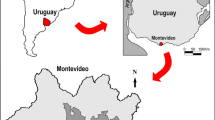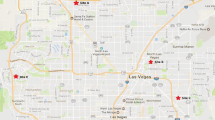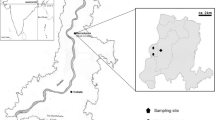Abstract
The occurrence and the abundance of the airborne fungi in the city of Athens have been studied by a volumetric non-culture-based method. During a period of 4 years, 562 glass slides were exposed during 562 sampling days, by a Burkard portable air sampler. A total of 259,851 fungal spores have been recovered and assigned to 24 genera of filamentous fungi, in addition to those recorded as groups. The annual mean concentration (AMC) of the total fungi was 865, 1,212, 937 and 1,206 spores/m3, and the concentration range was 89–3,175, 63–7,628, 62–4,323 and 29–10,187 spores/m3 for each year, respectively. There is no statistically significant variation in the AMC and in the distribution patterns of the total fungi from year to year. The temporal variation of the total fungi and of the dominant genera Cladosporium and Alternaria presented a significant increase during the warm months of each year. The results of the present study compared with data available by a culture-based method confirmed the complementarity of the two sampling procedures. The non-culture-based method was more efficient for the quantification of the total fungal count as well as of the genera Cladosporium and Alternaria, although less effective for the quantification of the genera Aspergillus and Penicillium.

Similar content being viewed by others
References
Adhikari, A., Sen, M. M., Gupta-Bhattacharya, S., & Chanda, S. (2004). Airborne viable, non-viable, and allergenic fungi in a rural agricultural area of India: A 2-year study at five outdoor sampling stations. Science of the Total Environment, 326, 123–141.
Aira, M. J., Rodríguez-Rajo, F. J., Fernández-González, M., Seijo, C., Elvira-Rendueles, B., Abreu, I., et al. (2013). Spatial and temporal distribution of Alternaria spores in the Iberian Peninsula atmosphere, and meteorological relationships: 1993–2009. International Journal of Biometeorology, 57, 265–274.
Aira, M. J., Rodríguez-Rajo, F. J., Fernández-González, M., Seijo, C., Elvira-Rendueles, B., Gutiérrez-Bustillo, M., et al. (2012). Cladosporium airborne spore incidence in the environmental quality of the Iberian Peninsula. Grana, 51, 293–304.
Almaguer, M., Aira, M. J., Rodríguez-Rajo, F. J., & Rojas, T. I. (2013). Study of airborne fungus spores by viable and non-viable methods in Havana, Cuba. Grana, 52(4), 289–298.
Bergamini, B. M., Grillenzoni, S., Andreoni, A. D., Natali, P., Ranzi, A., & Bertolani, M. F. (2004). Alternaria spores at different heights from the ground. Allergy, 59, 746–752.
Burge, H. P., Boise, J. R., Rutherford, J. A., & Solomon, W. R. (1977). Comparative recoveries of airborne fungus spores by viable and non-viable modes of volumetric collection. Mycopathologia, 61, 27–33.
Chakrabarti, H. S., Das, S., & Gupta-Bhattacharya, S. (2012). Outdoor airborne fungal spora load in a suburb of Kolkata, India: Its variation, meteorological determinants and health impact. International Journal of Environmental Health Research, 22(1), 37–50.
Corden, J., & Millington, W. (2001). The long-term trends and seasonal variation of the aeroallergen Alternaria in Derby UK. Aeobiologia, 17, 127–136.
Crotzer, V., & Levetin, E. (1996). The aerobiological significance of smut spores in Tulsa, Oklahoma. Aerobiologia, 12, 177–184.
D’Amato, G., Stanziola, A. A., Cocco, G., & Melillo, G. (1984). Mold allergy: A three year investigation (1980–1982) of the airborne fungal spores in Naples, Italy. Annals of Allergy, 52(5), 363–367.
Das, S., & Gupta-Bhattacharya, S. (2012). Monitoring and assessment of airborne fungi in Kolkata, India, by viable and non-viable air sampling methods. Environmental Monitoring and Assessment, 184, 4671–4684.
de Antoni Zoppas, B. C., Valencia-Barrera, R. M., Vergamini Duso, S. M., & Fernández-González, D. (2006). Fungal spores prevalent in the aerosol of the city of Caxias do Sul, Rio Grande do Sul, Brazil, over a 2-year period (2001–2002). Aerobiologia, 22, 119–126.
Després, V. R., Huffman, J. A., Burrows, S. M., Hoose, C., Safatov, A. S., Buryak, G., et al. (2012). Primary biological aerosol particles in the atmosphere: A review. Tellus, B64, 15598.
Fernádez-Rodríguez, S., Tormo-Molina, R., Maya-Manzano, J. M., Silva-Palacios, I., & Gonzalo-Garijo, A. (2014). Outdoor airborne fungi captured by viable and nonviable methods. Fungal Ecology, 7, 16–26.
Fröhlich-Nowoisky, J., Pickersgill, D. A., Després, V. R., & Pöschl, U. (2009). High diversity of fungi in air particulate matter. Proceedings of the National Academy of Sciences USA, 106(31), 12814–12819.
Giner, M. M., Garcia, J. S. C., & Camacho, C. N. (2001). Airborne Alternaria in SE Spain (1993–98). Grana, 40, 111–118.
Gioulekas, D., Damialis, A., Mpalafoutis, C., Papakosta, D., Giouleka, P., & Patakas, D. (2004). Allergenic fungal spore records (15 Years) and relationship with meteorological parameters in Thessaloniki, Greece. Allergy and Clinical Immunology International, 16(2), 1–8.
Gioulekas, D., Damialis, A., Papakosta, D., Syrigou, A., Mpaka, G., Saxoni, F., et al. (2003). 15-Year aeroallergen records. Their usefulness in Athens Olympics, 2004. Allergy, 58, 933–938.
Green, B. J., Sercombe, J. K., & Tovey, E. R. (2005). Fungal fragments and undocumented conidia function as new aeroallergen sources. Journal of Allergy and Clinical Immunology, 115, 1043–1048.
Grinn-Gofrón, A., & Rapiejko, P. (2009). Occurrence of Cladosporium spp. and Alternaria spp. spores in Western, Northern and Central-Eastern Poland in 2004–2006 and relations to some meteorological factors. Atmospheric Research, 93(4), 747–758.
Hasnain, S. M., Fatima, K., Al-Frayh, A., & Al-Sadairy, S. (2005). Prevalence of airborne basidiospores in three coastal cities of Saudi Arabia. Aerobiologia, 21, 139–145.
Henríquez, V. I., Villegas, G. R., & Roure Nolla, J. M. (2001). Airborne fungi monitoring in Santiago, Chile. Aerobiologia, 17, 137–142.
Herrero, A. D., Sabariego Ruiz, S., Bustillo, M. G., & Morales, P. C. (2006). Study of airborne fungal spores in Madrid, Spain. Aerobiologia, 22, 135–142.
Ho, H. M., Rao, C. Y., Hsu, H. H., Chiu, Y. H., Liu, C. M., & Chao, H. J. (2005). Characteristics and determinants of ambient fungal spores in Hualien, Taiwan. Atmospheric Environment, 39, 5839–5850.
Inal, A., Karakoc, G. B., Altintas, D. U., Pinar, M., Ceter, T., Yilmaz, M., et al. (2008). Effect of outdoor fungus concentrations on symptom severity of children with asthma and/or rhinitis monosensitized to molds. Asian Pacific Journal of Allergy and Immunology, 26, 11–17.
Kasprzyk, I., & Worek, M. (2006). Airborne fungal spores in urban and rural environments in Poland. Aerobiologia, 22, 169–176.
Lacey, J. (1991). Aerobiology and health: The role of airborne fungal spores in respiratory disease. In D. L. Hawksworth (Ed.), Frontiers in mycology (pp. 157–185). Wallingford: CAB International.
Leyronas, C., & Nicot, P. C. (2013). Monitoring viable airborne inoculum of Botrytis cinerea in the South-East of France over 3 years: Relation with climatic parameters and the origin of air masses. Aerobiologia, 29(2), 291–299.
Li, D. W., & Kendrick, B. (1995). A year-round outdoor aeromycological study in Waterloo, Ontario, Canada. Grana, 34, 199–207.
Lim, S. H., Chew, F. T., Mohd Dali, S. D. B., Tan, H. T. W., Lee, B. W., & Tan, T. K. (1998). Outdoor airborne fungal spores in Singapore. Grana, 37, 246–252.
Mallo, A. C., Nitiu, D. S., & Gardella Sambeth, M. C. (2011). Airborne fungal spore content in the atmosphere of the city of La Plata, Argentina. Aerobiologia, 27, 77–84.
Mitakakis, T. Z., & Mcgee, P. A. (2000). Reliability of measures of spores of Alternaria and pollen concentrations in air over two towns in rural Australia. Multiple sites for Burkard sampling. Grana, 39, 141–145.
Oliveira, M., Ribeiro, H., & Abreu, I. (2005). Annual variation of fungal spores in the atmosphere of Porto: 2003. Annals of Agricultural and Environmental Medicine, 12, 309–315.
Oliveira, M., Ribeiro, H., Delgado, J. L., & Abreu, I. (2009). Seasonal and intradiurnal variation of allergenic fungal spores in urban and rural areas of the North of Portugal. Aerobiologia, 25, 85–98.
Pashley, C. H., Fairs, A., Free, R. C., & Wardlaw, A. J. (2012). DNA analysis of outdoor air reveals a high degree of fungal diversity, temporal variability, and genera not seen by spore morphology. Fungal Biology, 116, 214–224.
Pongracic, J. A., O’Connor, G. T., Muilenberg, M. L., Vaughn, B., Gold, D. R., Kattan, M., et al. (2010). Differential effects of outdoor versus indoor fungal spores on asthma morbidity in inner-city children. Journal of Allergy and Clinical Immunology, 125(3), 593–599.
Pyrri, I., & Kapsanaki-Gotsi, E. (2006). Diurnal fluctuations of airborne mycobiota in Athens, Greece. European Annals of Allergy and Clinical Immunology, 39(1), 33.
Pyrri, I., & Kapsanaki-Gotsi, E. (2007). A comparative study on the airborne fungi in Athens, Greece, by viable and non-viable sampling methods. Aerobiologia, 23, 3–15.
Pyrri, I., & Kapsanaki-Gotsi, E. (2012). Diversity and annual fluctuations of culturable airborne fungi in Athens, Greece: A 4-year study. Aerobiologia, 28, 249–262.
Sakiyan, N., & Inceoğlu, O. (2003). Atmospheric Concentrations of Cladosporium Link and Alternaria Nées spores in Ankara and the effects of meteorological factors. Turkish Journal of Botany, 27, 77–81.
Sánchez, E., Rodríguez, D., Sanchís, M. E., & Sánchez, J. (2009). Meteorological and agricultural effects on airborne Alternaria and Cladosporium conidia and clinical aspects in Valladolid (Spain). Annals of Agricultural and Environmental Medicine, 16, 53–61.
Stępalska, D., & Wołek, J. (2005). Variation in fungal spore concentrations of selected taxa associated to weather conditions in Cracow, Poland 1997. Aerobiologia, 21, 43–52.
Author information
Authors and Affiliations
Corresponding author
Rights and permissions
About this article
Cite this article
Pyrri, I., Kapsanaki-Gotsi, E. Evaluation of the fungal aerosol in Athens, Greece, based on spore analysis. Aerobiologia 31, 179–190 (2015). https://doi.org/10.1007/s10453-014-9355-1
Received:
Accepted:
Published:
Issue Date:
DOI: https://doi.org/10.1007/s10453-014-9355-1




